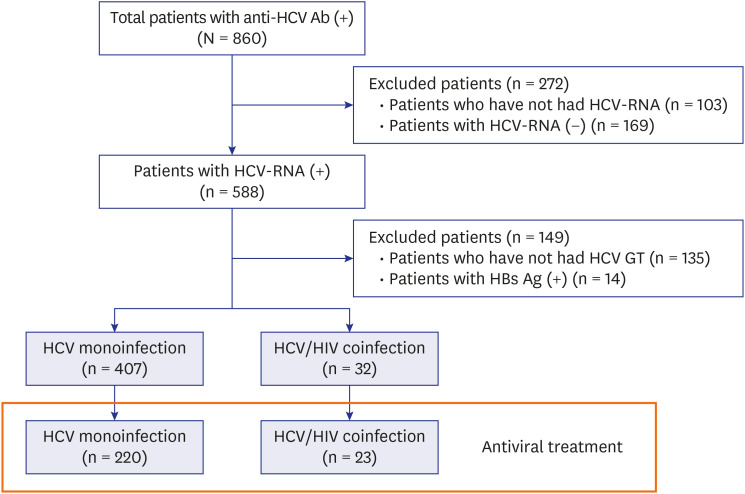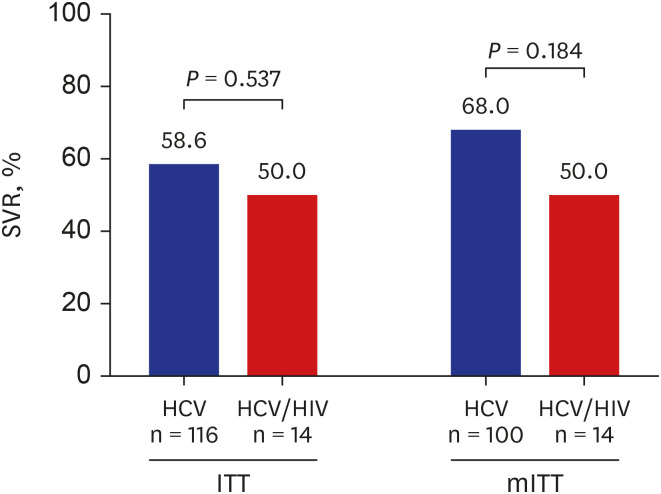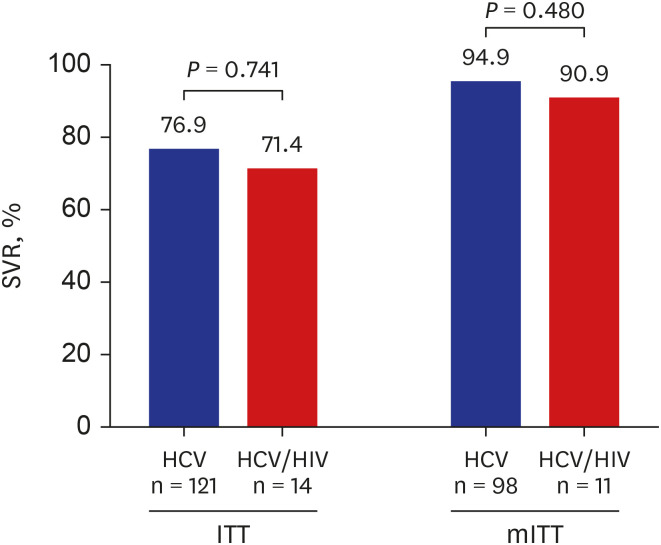J Korean Med Sci.
2021 Nov;36(46):e308. 10.3346/jkms.2021.36.e308.
Clinical Characteristics and Treatment Outcomes of Patients with Hepatitis C Virus and Human Immunodeficiency Virus Coinfection: Experience at a Single Center in Korea
- Affiliations
-
- 1Division of Gastroenterology and Hepatology, Department of Internal Medicine, National Medical Center, Seoul, Korea
- 2Division of Infectious Diseases, Department of Internal Medicine, National Medical Center, Seoul, Korea
- KMID: 2522883
- DOI: http://doi.org/10.3346/jkms.2021.36.e308
Abstract
- Background
Because of the very low incidence of human immunodeficiency virus (HIV) coinfection in Korea, data on hepatitis C virus (HCV)/HIV coinfection are limited. This study aimed to investigate the clinical characteristics and treatment outcomes of patients with HCV/HIV coinfection in Korea.
Methods
We performed a retrospective cohort study of all HCV-monoinfected and HCV/ HIV-coinfected patients treated with antivirals at National Medical Center in Seoul, Korea, between January 2009 and March 2020.
Results
We enrolled 220 HCV-monoinfected and 23 HCV/HIV-coinfected patients treated with antivirals. The HCV/HIV-coinfected patients were younger (HCV vs. HCV/HIV: 57.3 ± 11.3 vs. 40.7 ± 10.1 years, P < 0.001) and had a higher proportion of men (HCV vs. HCV/ HIV: 54.5% [n = 120] vs. 91.3% [n = 21], P < 0.001) than the HCV-monoinfected patients. Genotype 1b and 2 were most common in both HCV monoinfection and HCV/HIV coinfection groups. HCV-monoinfected patients had a higher incidence of genotype 1b and 2 than HCV/HIV-coinfected patients (HCV vs. HCV/HIV: 95.4% [n = 210] vs. 73.9% [n = 17], P < 0.001), while the HCV/HIV-coinfected patients had genotype 1a (HCV vs. HCV/HIV: 1.8% [n = 4] vs. 21.7% [n = 5], P < 0.001). The fibrosis-4 index was significantly lower in the HCV/ HIV-coinfected patients than in the HCV-monoinfected patients (HCV vs. HCV/HIV: 3.81 ± 3.38 vs. 1.66 ± 1.10, P < 0.001). Among the direct-acting antivirals (DAA)-treated patients, the sustained viral response (SVR) rate did not differ significantly between both groups (HCV vs.HCV/HIV: 94.9% [93/99] vs. 90.9% [10/11], P = 0.480).
Conclusion
In Korea, the HCV/HIV-coinfected patients who received antiviral treatment were younger, had higher proportion of men and incidence of genotype 1a, and had less advanced fibrosis than the HCV-monoinfected patients. In actual clinical settings, HCV/HIV-coinfected patients show excellent SVR to DAA treatment, similar to HCVmonoinfected patients.
Figure
Reference
-
1. Messina JP, Humphreys I, Flaxman A, Brown A, Cooke GS, Pybus OG, et al. Global distribution and prevalence of hepatitis C virus genotypes. Hepatology. 2015; 61(1):77–87. PMID: 25069599.
Article2. Jeong SH, Jang ES, Choi HY, Kim KA, Chung W, Ki M. Current status of hepatitis C virus infection and countermeasures in South Korea. Epidemiol Health. 2017; 39:e2017017. PMID: 28774165.
Article3. Kim KA, Lee JS. Prevalence, awareness, and treatment of hepatitis C virus infection in south korea: evidence from the Korea National Health and Nutrition Examination Survey. Gut Liver. 2020; 14(5):644–651. PMID: 31842525.
Article4. World Health Organization. Global progress report on HIV, viral hepatitis and sexually transmitted infections. Updated 2021. Accessed September 10, 2021. https://www.who.int/publications/i/item/9789240027077 .5. Utsumi T, Lusida MI. Viral hepatitis and human immunodeficiency virus co-infections in Asia. World J Virol. 2015; 4(2):96–104. PMID: 25964874.
Article6. Kim JM, Kim NJ, Choi JY, Chin BS. History of acquired immune deficiency syndrome in Korea. Infect Chemother. 2020; 52(2):234–244. PMID: 32618149.
Article7. Korea Centers for Disease Control & Prevention. Annual report on the notified HIV/AIDS in Korea 2019. Korea Centers for Disease Control & Prevention;Updated 2020. Accessed March 13, 2021. https://www.aids.or.kr/bbs/board.php?bo_table=sub04_03&wr_id=10 .8. Lee S, Lee SH, Lee SJ, Kim KH, Lee JE, Cho H, et al. Incidence and risk factors of hepatitis C virus infection among human immunodeficiency virus (HIV) patients in a large HIV clinic in South Korea. Korean J Intern Med (Korean Assoc Intern Med). 2016; 31(4):772–778.
Article9. Vogel M, Page E, Boesecke C, Reiberger T, Schwarze-Zander C, Mauss S, et al. Liver fibrosis progression after acute hepatitis C virus infection in HIV-positive individuals. Clin Infect Dis. 2012; 54(4):556–559. PMID: 22156856.
Article10. Fierer DS, Dieterich DT, Fiel MI, Branch AD, Marks KM, Fusco DN, et al. Rapid progression to decompensated cirrhosis, liver transplant, and death in HIV-infected men after primary hepatitis C virus infection. Clin Infect Dis. 2013; 56(7):1038–1043. PMID: 23264364.
Article11. Graham CS, Baden LR, Yu E, Mrus JM, Carnie J, Heeren T, et al. Influence of human immunodeficiency virus infection on the course of hepatitis C virus infection: a meta-analysis. Clin Infect Dis. 2001; 33(4):562–569. PMID: 11462196.
Article12. Bhattacharya D, Belperio PS, Shahoumian TA, Loomis TP, Goetz MB, Mole LA, et al. Effectiveness of all-oral antiviral regimens in 996 human immunodeficiency virus/hepatitis C virus genotype 1-coinfected patients treated in routine practice. Clin Infect Dis. 2017; 64(12):1711–1720. PMID: 28199525.
Article13. Osinusi A, Townsend K, Kohli A, Nelson A, Seamon C, Meissner EG, et al. Virologic response following combined ledipasvir and sofosbuvir administration in patients with HCV genotype 1 and HIV co-infection. JAMA. 2015; 313(12):1232–1239. PMID: 25706232.
Article14. Sulkowski MS, Naggie S, Lalezari J, Fessel WJ, Mounzer K, Shuhart M, et al. Sofosbuvir and ribavirin for hepatitis C in patients with HIV coinfection. JAMA. 2014; 312(4):353–361. PMID: 25038354.
Article15. Hawkins C, Grant J, Ammerman LR, Palella F, Mclaughlin M, Green R, et al. High rates of hepatitis C virus (HCV) cure using direct-acting antivirals in HIV/HCV-coinfected patients: a real-world perspective. J Antimicrob Chemother. 2016; 71(9):2642–2645. PMID: 27330060.
Article16. Kim YC, Ahn JY, Kim JM, Kim YJ, Park DW, Yoon YK, et al. Human immunodeficiency virus (HIV) and hepatitis virus coinfection among HIV-infected Korean patients: the Korea HIV/AIDS cohort study. Infect Chemother. 2017; 49(4):268–274. PMID: 29299894.
Article17. Korean Association for the Study of the Liver. KASL clinical practice guidelines: management of hepatitis C. Clin Mol Hepatol. 2016; 22(1):76–139. PMID: 27044763.18. Korean Association for the Study of the Liver (KASL). 2017 KASL clinical practice guidelines management of hepatitis C: Treatment of chronic hepatitis C. Clin Mol Hepatol. 2018; 24(3):169–229. PMID: 30092624.19. Kirk GD, Mehta SH, Astemborski J, Galai N, Washington J, Higgins Y, et al. HIV, age, and the severity of hepatitis C virus-related liver disease: a cohort study. Ann Intern Med. 2013; 158(9):658–666. PMID: 23440167.20. Carrat F, Bani-Sadr F, Pol S, Rosenthal E, Lunel-Fabiani F, Benzekri A, et al. Pegylated interferon alfa-2b vs standard interferon alfa-2b, plus ribavirin, for chronic hepatitis C in HIV-infected patients: a randomized controlled trial. JAMA. 2004; 292(23):2839–2848. PMID: 15598915.21. Ioannou GN, Scott JD, Yang Y, Green PK, Beste LA. Rates and predictors of response to anti-viral treatment for hepatitis C virus in HIV/HCV co-infection in a nationwide study of 619 patients. Aliment Pharmacol Ther. 2013; 38(11-12):1373–1384. PMID: 24127691.
Article22. Gayam V, Hossain MR, Khalid M, Chakaraborty S, Mukhtar O, Dahal S, et al. Real-world clinical efficacy and tolerability of direct-acting antivirals in hepatitis C monoinfection compared to hepatitis c/human immunodeficiency virus coinfection in a community care setting. Gut Liver. 2018; 12(6):694–703. PMID: 29938459.
Article23. Zheng YX, Ma SJ, Xiong YH, Fan XG. Efficacy and safety of direct acting antiviral regimens for hepatitis C virus and human immunodeficiency virus co-infection: systematic review and network meta-analysis. J Gastroenterol Hepatol. 2020; 35(9):1477–1487. PMID: 32246857.
Article
- Full Text Links
- Actions
-
Cited
- CITED
-
- Close
- Share
- Similar articles
-
- Efficacy of Direct-Acting Antivirals in Patients with Hepatitis C Virus/Human Immunodeficiency Virus Coinfection: A Gap between Clinical Trial and Real Practice
- A Case of Coinfection of Hepatitis A and E Virus with Hepatic Encephalopathy
- Prevention of Viral Hepatitis and Vaccination
- A Case of Ankylosing Spondylitis in a Patient with Human Immunodeficiency Virus
- Treatment Outcomes of HCV Infection in People Living with HIV: A Case Series from a Single Center in Korea





